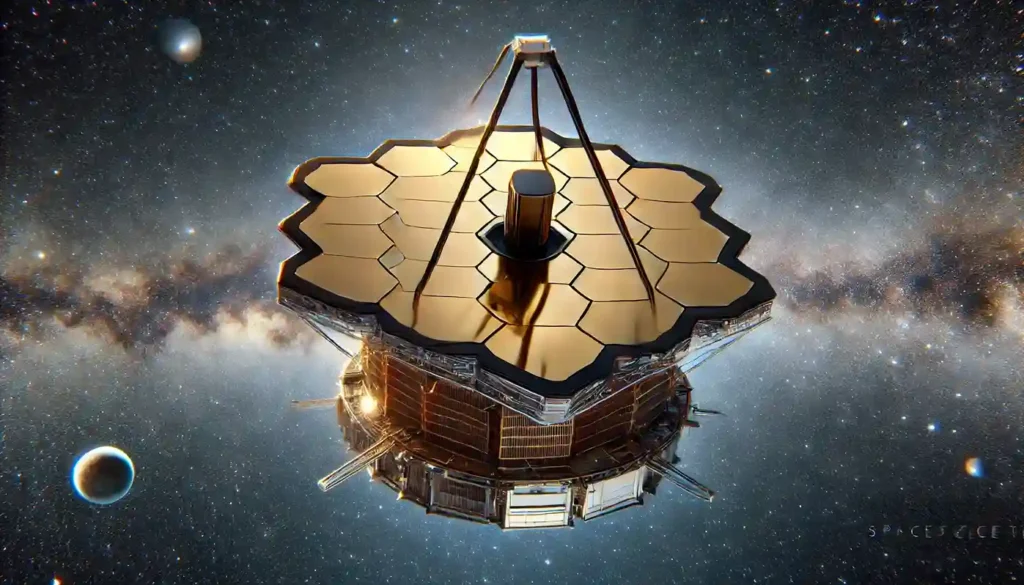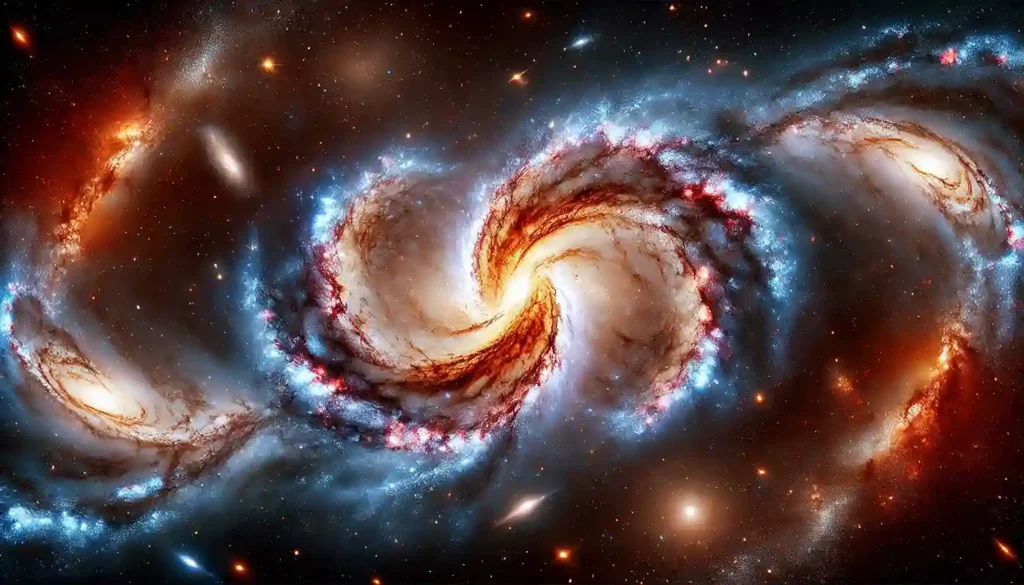Once again, the global event of revelation took place under the auspices of the James Webb Space Telescope: this time, it brought forth what can be described as a question mark depicting two chummy galaxies. Such a great image shares not only the extensive versatility and power of the JWST but also enables the people to watch the cosmic dealings of the universe.
Here, in this blog post, we are going to discuss how important this new image is, what kind of science is at stake, and all that this can probably engage regarding the universe.
The James Webb Space Telescope: Section 1 Overview
In order to really appreciate the enormity of the new image, we have to have a look at what is, indeed, a most wonderful instrument for video-capturing. Launched on the 25th day of December in 2021, the James Webb Space Telescope is the mission jointly between NASA, ESA and CSA. With the very latest technology, JWST is set up to capture objects in space-time further than ever possible before replacing the Hubble Space Telescope.
Main Characteristics of the James Webb Space Telescope
Infrared Observation: Compared particular to Hubble, JWST being totally brand new, it is not that well qualified to capture all visible and ultraviolet light wavelengths. But, however, it was designed to capture the entire range of infrared wavelength from electromagnetic spectrum such as this, making it capable of really seeing through various layers of cosmic dust and getting images of distant and often fuzzy galaxies.
Gigantic Mirror
Every night-sky survey involves a task that confines itself to its great 21-meter primary. While Hubble’s is a space telescope with a closed base diameter of 2.4 m (7.8 ft), the new one will be 8.4 ft or 3 ft (6.5 m) in diameter. It turns that into bigger mirrors through which JWST can capture more light, and consequently observe what is not easily seen.
Sunshade
Sunshield will make a sunshutter just like slightly less sneaking than a table tennis table for the JWST instrument. With the instrument shielded, the sun must be kept warm to carry out infrared astronomy.
The form of an innocent question mark is not unusual to the sky, but in this one, there is something that is definitely suspicious because an impression of something that looks like a new born galaxy image is formed.
This is one of the latest images that come out from the James Webb telescope, showing what seems to be two galaxies about to merge. This is the shape formed by this merger that resembles a question mark. It is by promethean gleam just as much as informative to one who associates fate with marine biology or even natural sciences generally.
Interesting Visual Experience
‘Question Mark Galaxy’ is a name given to it because the two compounding the shape practically never seem to align such that. Merging galaxies occur quite frequently in the universe but rarely do so in formations as peculiar with the merging of these two spirals. Many features of space separated out into wonderful images from the picture, especially the nature of space and the coalescing mergers of galaxies.
Importance in Scientific Research

Galactic Mergers
The merger of galaxies is one of the very important events that occur during galactic evolution. Often, it leads to forming new stars, but such coupling between the galaxies also has effects on the structure of the combined galaxy, and, in turn, on the evolution of quasars – super massive black holes at the galactic centers.
Star Formation
This is a view of regions of high activity related to the formation of stars: bright colorful areas in the picture itself. Interactions between galaxies generally consist of collisions and merging between galaxy systems, resulting in compressing interstellar gas and dust and leading to the birth of new stars and star clusters.
Dark Matter and Black Holes
The entire quartet of galaxies opens a page about how they are exposed to rip apart by gravity and to flow around supermassive black holes in dark matter. Here, the gravitational forces of black holes and the effect of dark matter are significant to the process of galactic merger.
Understanding the Science Behind the Image

In order to understand the extent of the above discussions, one needs to center the scientific processes pertaining to the evolution of the shape-the question-mark formation in the galaxy merger.
The Merger Process
Galactic mergers are processes that take billions of years and state how more or less a given galaxy interacts with one’s neighbors. When two galaxies get close enough for gravity to start working on both, this fallout has tidal forces as a result of which the galaxies get pulled into compressed, elongated shapes. Such actions could result in intense star formations and end up in formations like the one that appears as a question mark in the JWST image.
Infrared Observations
James Webb Telescope essentially uses the infrared region of the spectrum for its merged galaxy studies. The dust that usually absorbs visible light and therefore prevents scientists from accessing up-close-looks at merging galaxies and all their processes can be penetrated by infrared radiation, allowing for stellar sources in gaseous and duct translocations to become visible.
Star Formation and Stellar Evolution
The bright regions visible in the image have gained this brightness due to active star formation from the interstellar dust and gas compressed between these mega-galactic structures, which are actually contributory to forming a giant star cluster, and the star formation process where star formation takes place. The JWST, in these regards, would enable astronomers in a broad sense to explore the life cycle of stars and impact gaseous galaxy interactions on the generation of stars.
The Function of Dark Matter
Dark matter is a type of matter that is believed to fill up at least twenty-five percent of the volume of space of the universe and can only be inferred by its gravitational effects upon other substances. Within that, it plays a significant role in the formation and organization of galaxies. Specifically, Nature says that the lessons galactic dark matter endows the merging galaxies behavior and figure. Some of the JWST findings help explain the part dark matter plays in developing the universe.
Theological Seminars
Thus the challenge of advancing theological education with the realization of the theological seminary image and the wider implications is actually worth pursuing.
On the other hand, the appearance of a galaxy merger that looks like a question mark captured by the James Webb Telescope may have some bearing to the much larger things. By that I mean the whole from universe to us within it.
Cosmic Evolution: This is a study concerned with galactic merger phenomena that can be informative in the course of understanding the formation and/or evolution of galaxies and other cosmological formations. Thus, by observing different stages of galaxy mergers, insight can be gained into galaxy development dynamics together with corresponding external factors that influence their growth.
Development of Supermassive Black Holes: The interaction between galaxies also creates and further develops supermassive black holes at … An understanding of the activity of these black holes, as well as how they are formed and evolved, is reckoned important for a proper understanding of galactic activity and the role that black holes play to the universe.
Insight into Early Universe: Observing the mergers that galaxies undergo enables the astronomers to understand the very different conditions and processes of the early universe. It is through the study of the very distant, highly receded galaxies that the astronomers hope to learn much about the fate of the universe since its birth, and that of the galaxies over time.
This is the future observation and discovery modality: How the new features of James Webb Space Telescope are expected to bring future discoveries within reach is by stating the detailed imaginations of galactic mergers. Now as JWST will penetrate deeper into the universe, it will be able to furnish more useful information and revelations on how intertwined the universe is.
Conclusion
The latest image taken by the James Webb Space Telescope as galaxies merge into a question mark shape is proof for modern astronomy and space exploration. This awesome picture shall not only attract the fancy of the mind but also provide some of the most desirable and probably priceless data in addressing the questions of galactic merging, star formation, and cosmological evolution.
It embodies a new hope that through the James Webb Space Telescope more will be discovered than has ever happened before and that understanding will accrue from all this. It is the formation of the question mark shaped galaxy merger that eloquently speaks of the more beautiful and fascinating universe and of exploration and adventure never ending.
FAQs
- What do astronomers mean by the James Webb Space Telescope (JWST)?
The JWST is a space telescope that was launched on the 25th of December 2021 and it is highly effective in observing the exterior space. It is built to function in a part of the spectrum that is infrared and therefore, is able to see through the dust to find far away or otherwise barely observable things. JWST is one of the ongoing international efforts of NASA, the European Space Agency (ESA) and the Canadian Space Agency (CSA).
- What is the most recently taken picture by JWST?
The very latest photos snapped into the memory by JWST portray two galaxies as they are about to merge into one such that it could shape itself into that of a question mark. This image has become a stunning shock because of the weaving networks in between galaxies and those double merging processes.
- Where does the shape of a question mark come from and why is it so important?
It essentially has to be underscored that the shape of a question mark has been quite deliberately chosen because of its exoticism and also due to the fact that thanks to its form, it brings forth such processes of galactic interaction to be brought into sharp focus. This particular morphology thus allows scientists a wealth of insight about how galaxies merge, interact and evolve as well.
- How does the James Webb Telescope capture such fine images?
JWST grabs marvelous pictures through the world by infrared provision and equipment. Sky’s biggest light-lighter is its enormous primary mirror, while its sensitive instruments are equipped to see the feeble and remote in the infrared spectrum; it is not obscured by dust in space like any other type of light.




